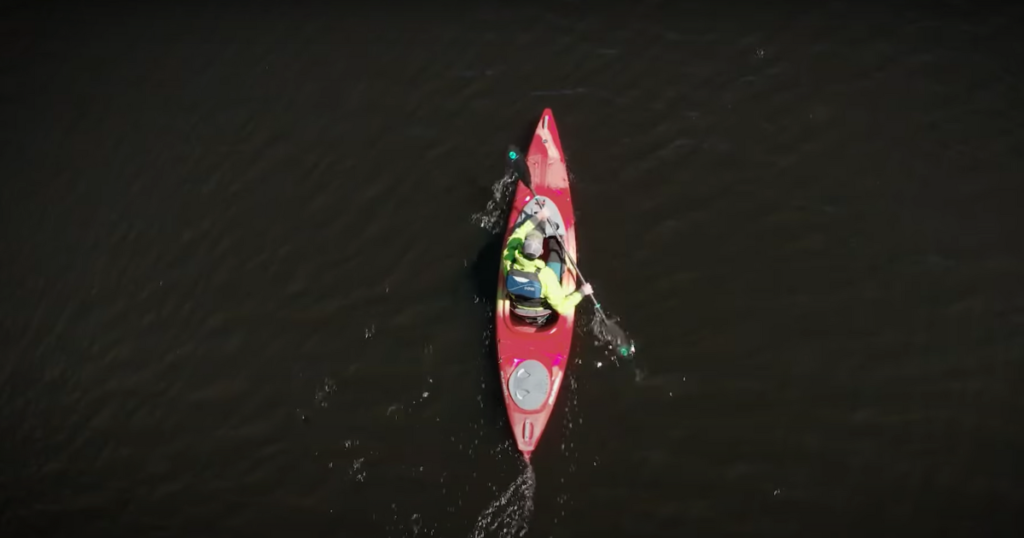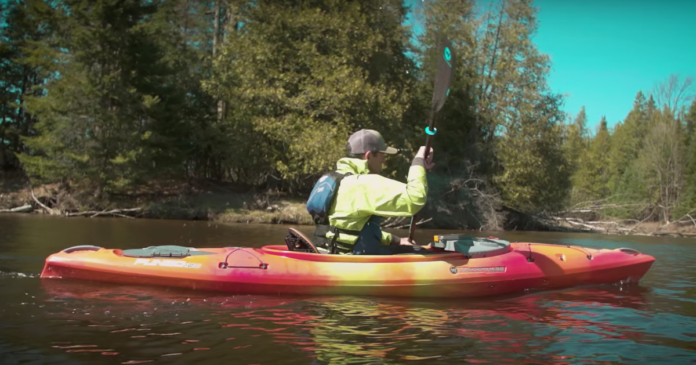Is the Pungo a ‘Best in Class' recreational kayak?
The Wilderness Systems Pungo has been one of the best selling recreational kayaks for around 25 years. That's an impressive accolade – especially when you consider that it's in the highly-competitive, mid-range kayak market.
Wilderness Systems touts the Pungo as being the easiest to paddle and the most efficient kayak in its class, with superior stability and premium comfort. That's a rather bold statement, and one that definitely warrants putting to the test. And so, I took the Pungo 120 to the water to find out why this model is so popular, and to determine whether it deserves to remain one of the best selling kayaks in the world.
The Pungo series comes in 3 sizes. The 105 is the shortest of the three, and therefore suited for smaller paddlers. The 120 is designed for small to large paddlers. And then the 125 is for large and extra-large folks. This review will pertain to the Pungo 120, although most of my comments will overlap with the smaller and larger models.
ABOUT THE PUNGO 120 KAYAK
Retail Price: $1099 USD (up from $999 in 2021)
Length: 12′ 2″
Width: 29″
Weight: 49 LBS (22KG)
Max Capacity: 325 LBS (147KG)
Best Use: Calm Water
The Pungo 120 has a range of basic features. It has heavy-duty handles on both ends, deck bungees on the bow and stern for stowing gear, and a secure rear hatch that seals with turn handles. A unique feature of the Pungo is the removable dashboard that comes with the kayak. It includes: cup holders, a storage box, slide tracks so that you can easily add accessories like phone or rod holders, and there's a compartment for a lithium battery, which is sold separately, to keep your electronics charged when you're on longer adventures.
Turning our attention to the inside of the kayak, the Pungo 120 has its Phase 3 AirPro seat, which is fully adjustable and quick drying, and it has low and high back support options. Behind the seat, the Pungo has a bulkhead, which you don't always find in mid-range kayaks. The bulkhead separates the kayak into two distinct, waterproof compartments, so that in the event of a capsize, the whole kayak won’t swamp. Additionally, the Pungo features a padded cockpit rim and adjustable foot pegs.

How to transport the Pungo kayak
At 49 pounds and 12 feet in length, the Pungo 120 is a very manageable kayak to get around. It’s always easiest for two people to move kayaks around. Especially true in this case with the Pungo's large and comfortable carry handles. It’s the kind of kayak that a strong person can reasonably load onto their vehicle’s roof racks or carry to and from the water by themselves. The padded cockpit rim makes it more comfortable on your legs when sitting. It also adds a cushion for your shoulders when carrying it solo. The Pungo also features a replaceable skid plate in case you decide to drag it to the water.

Is the Pungo kayak stable?
A lot of recreational kayaks these days seem to put a strong emphasis on primary/initial stability (i.e. how it feels just sitting in the kayak). They do this by implementing a flat hull, which comes at the cost of speed and paddling efficiency. The Pungo 120 has a V-shaped hull, which gives up a bit of primary stability for the gain of performance (speed and maneuverability). Don’t get me wrong though, it's still a very stable kayak!
Secondary stability from V-Hull
The V-hull also gives the kayak great secondary stability. What this means is that as soon as you put this kayak on edge, it wants to sit there compliantly. This may not matter as much to you if you just want something that you can casually cruise around in. But if you're like me and want to maneuver around stumps, and trees, and zip under some overhangs, it's great to have a boat that you can put on edge because it helps to turn a lot more easily. Either way, I'd feel comfortable putting anyone in this kayak.
What is the performance of the Pungo kayak?
The V-hull makes the Pungo 120 surprisingly fast for a 12-foot boat. I really appreciate that, because I’m the kind of person that gladly gives up the absolute highest possible stability for better paddling performance.
Testing day was windy
It was a windy day when I hit the water and this turned out to be a blessing in disguise. It highlighted how fast the Pungo is and how well it tracks (it does a great job of keeping a line without having a rudder/skeg).
Maneuverability of the kayak
When it comes to maneuverability, the Pungo also gets top marks. It’s easy to turn, pivot and get moving the way you want it to. The fact that it has such great secondary stability (stability when tilted on edge) also enhances its maneuverability.
Is the Pungo kayak comfortable?
The Phase 3 AirPro seating system is fantastic. I remember the Wilderness Systems Pungo being comfortable when I first tried it, 15+ years ago. Well, time has only served to improve on this.
Seating adjustments
There are so many adjustments that allow you to tailor it specifically to your needs. In particular, there's a piece underneath that you can pull up, with an easy-grab handle, to provide support under your legs. This is a huge bonus if you're paddling long days. The adjustable back support is a perfect compliment to create a comfortable setup. Basically, I have nothing but good things to say about the seating.
Foot Pegs
The foot pegs allow for a wide range of paddlers to sit naturally in this kayak. To give you some reference, I'm 6'2″, 200LBS, and I had them set to about 2/3rds length. That means that even though the Pungo 120 is suggested for small to large paddlers, you could still fit someone considerably taller in there before upgrading to the Pungo 125 (i.e. extra-large).

What are the features of the Pungo kayak?
In terms of features, the Pungo 120 has everything a typical recreational kayaker would need. The additions are simple, but satisfying. The dashboard is a nice addition, even though I was worried that it was going to be a gimmick, or worse, an annoyance while paddling.
At first glance, I wondered if I might scrape my knuckles or knock my knees on it, but the paddle test proved me wrong. There's lots of space to act as a buffer. I didn't feel hindered at all. The dashboard turned out to be a unique selling feature, although I would probably use the kayak without it most of the time.
Other nice touches include: the adjustable deck bungees up front, which help accommodate a range of different sized gear, the padded cockpit rim, which enhances leg comfort (and again, shoulder comfort if carrying), the locking hatches, which work very smoothly to seal the kayak's bulkheads, and finally, the adjustable foot pegs are, in my opinion, an essential feature.
One thing that is noticeably missing, by my standard, is having some gear tracks behind the seat so that you can add a rod holder and quickly turn this thing into a fishing machine. Thankfully, that's a very simple addition to make yourself.

Who is the Pungo 120 kayak for?
Anyone who's looking for a fast, recreational kayak, where you can cover ground and have fun while paddling in calm water (i.e. sheltered from any significant wind or waves), will find a home in the Pungo 120. If you're solely focused on the highest possible stability, particularly initial stability, then you will find some better options out there. That being said, this IS a stable boat – especially considering how well it moves.
Anyone who has struggled to find a comfortable setup in a kayak will also feel right at home in the Pungo series. The various adjustable supports will get you dialed in for lengthy outings. Based on my height and build (6′ 2″/200 LBS), I'd say that the Pungo 120 would still work well for anyone upwards of 240 LBS, and a few foot-peg-settings taller.
Is the Pungo kayak worth the price?
It had been a while since I paddled the Wilderness Systems Pungo series. I've tested a lot of kayaks since then and so I wasn't sure what to expect upon my return. So to answer the question: Does the Pungo deserve to be one of the best selling kayaks in the world? – My answer is yes. 20+ years on and this kayak still proves to be a solid offering in a lot of ways.
In terms of ‘bang for the buck,' it's right in that upper echelon for value. I've tested some others that are comparable in this department, and so I'm not quite ready to designate the Pungo 120 as the best value in the world, but it does deserve to be one of the best selling kayaks in the world. There's no doubt about that.
How do you choose between this model and some of the other mid-range, recreational kayaks? Well, it simply comes down to what's most important to you. If you're willing to give up a little bit of stability (but just a little!) in favor of speed and paddling efficiency then this is your boat.
The Wilderness Systems Pungo 120 is a fast, comfortable, rec-kayak, and I love that. If you decide to go with this model, then you've made a wonderful choice and you won't be disappointed.
I hope you enjoyed this article. For more information, check out my gear reviews, tips, and adventures on PaddlingTV.






